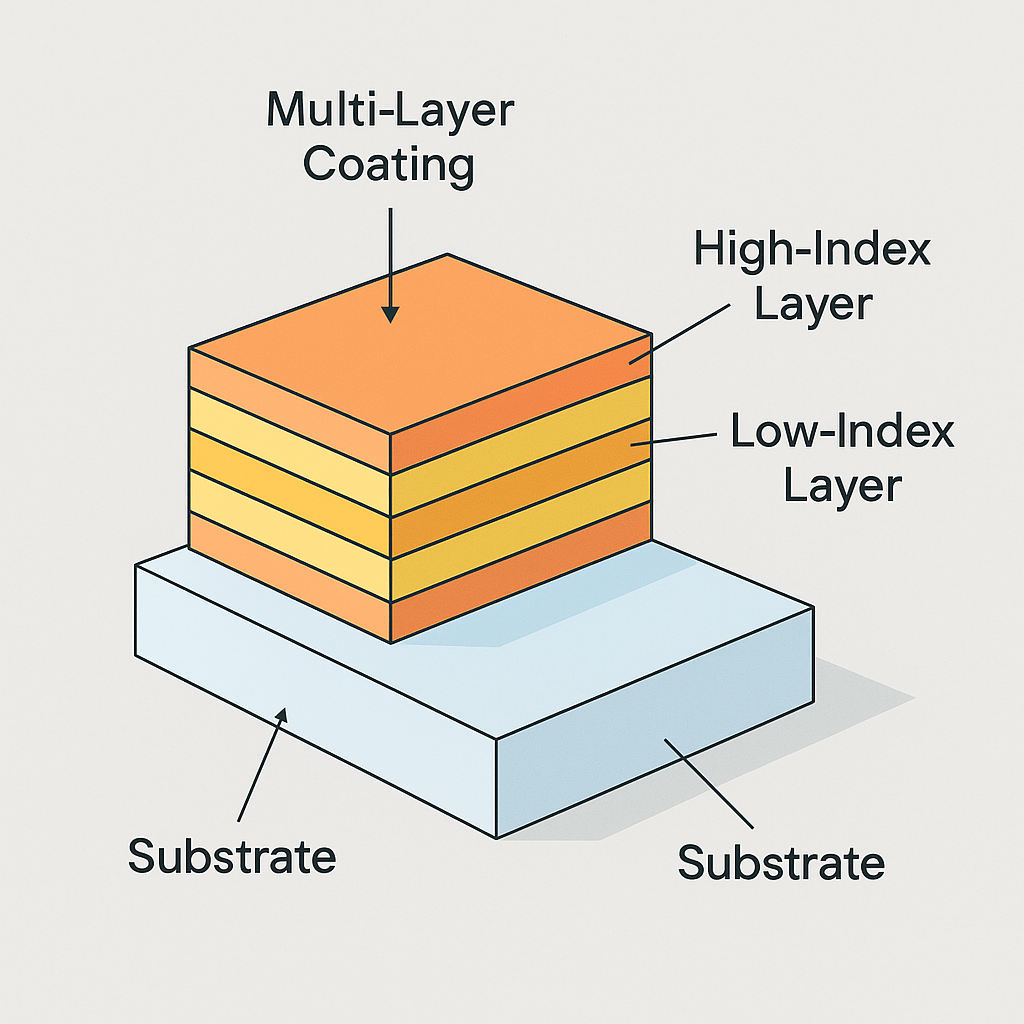
The Mathematics Behind the Magic: Quantum Computing, AI, and Optical Polarization.
Tuesday, 8 July, 2025The Ultimate Guide to Micro Prisms: Applications, Types, and Future Trends
Friday, 15 August, 2025Precision Optical Coatings
Introduction to Precision Optical Coatings
The Science Behind Optical Coatings
2.1 Thin-Film Interference
2.2 Refractive Index Engineering
Key Functions of Precision Optical Coatings
3.1 Reflection Control
3.2 Transmission Enhancement
3.3 Polarization Management
Common Types of Precision Optical Coatings
4.1 Antireflection (AR) Coatings
4.2 High-Reflective (HR) Coatings
4.3 Beamsplitter Coatings
4.4 Polarizing Coatings
4.5 Bandpass and Edge Filters
Materials Used in Optical Coating Fabrication
Deposition Techniques for Optical Coatings
6.1 Physical Vapor Deposition (PVD)
6.2 Ion-Assisted Deposition (IAD)
6.3 Electron-Beam Evaporation
6.4 Magnetron Sputtering
Performance Metrics and Quality Standards
7.1 Optical Density and Transmission
7.2 Damage Threshold Ratings
7.3 Environmental Stability Testing
Applications of Precision Optical Coatings
8.1 Laser Systems
8.2 Aerospace and Defense Optics
8.3 Medical and Biomedical Imaging
8.4 Semiconductor Manufacturing
Challenges in Optical Coating Design
9.1 Spectral Bandwidth Requirements
9.2 Thermal and Mechanical Durability
9.3 Adhesion and Surface Contamination
Future Trends in Optical Coating Technology
Conclusion: The Strategic Value of Coatings in Precision Optics
Precision Optical Coatings
1. Introduction to Precision Optical Coatings
Precision optical coatings are engineered, nanometer-scale layers applied to optical components to manipulate the way light interacts with a surface. By carefully designing the coating’s structure, manufacturers can control reflectance, transmittance, absorption, and polarization—ensuring that optics meet stringent performance criteria in highly specialized applications. These coatings are not decorative; they are foundational to the performance of modern optical systems.
2. The Science Behind Optical Coatings
2.1 Thin-Film Interference
At the heart of precision coatings is thin-film interference, where light waves reflecting off multiple surfaces interfere constructively or destructively. By manipulating layer thickness and refractive indices, engineers fine-tune this interference to amplify or suppress specific wavelengths.
2.2 Refractive Index Engineering
Refractive index control allows for the creation of alternating high and low-index materials, forming dielectric stacks that precisely alter light propagation. This manipulation enables coatings to achieve extreme reflectivity or near-total transparency at target wavelengths.
3. Key Functions of Precision Optical Coatings
3.1 Reflection Control
Coatings can be designed to minimize surface reflections that otherwise degrade system performance, particularly in multi-element lens assemblies.
3.2 Transmission Enhancement
By suppressing unwanted reflections, coatings improve overall light throughput, increasing signal strength and measurement accuracy.
3.3 Polarization Management
Certain coatings can manipulate light polarization states—essential for lasers, polarimeters, and optical communication systems.
4. Common Types of Precision Optical Coatings
4.1 Antireflection (AR) Coatings
AR coatings reduce reflectance to less than 0.1% at specific wavelengths, critical in applications where maximum transmission is needed.
4.2 High-Reflective (HR) Coatings
HR coatings achieve reflectivity exceeding 99.9%, often used in laser resonators, beam steering, and astronomical mirrors.
4.3 Beamsplitter Coatings
These coatings divide light into transmitted and reflected beams in controlled ratios, enabling interferometry and dual-path imaging.
4.4 Polarizing Coatings
Used to separate or combine polarized light beams, these coatings are indispensable in projection systems and laser optics.
4.5 Bandpass and Edge Filters
Engineered to pass or block specific spectral bands, these coatings serve in fluorescence microscopy, spectroscopy, and optical sensing.
5. Materials Used in Optical Coating Fabrication
Precision coatings are built from materials with carefully selected optical and physical properties, including:
Silicon Dioxide (SiO₂) – Low-index, high transparency
Titanium Dioxide (TiO₂) – High-index, broadband capability
Magnesium Fluoride (MgF₂) – UV transparency
Zinc Selenide (ZnSe) – IR applications
Material purity and deposition control are critical to maintaining optical clarity and performance stability.
6. Deposition Techniques for Optical Coatings
6.1 Physical Vapor Deposition (PVD)
A vacuum-based process that vaporizes materials, condensing them onto substrates in controlled layers.
6.2 Ion-Assisted Deposition (IAD)
Combines PVD with ion bombardment to enhance coating density, adhesion, and environmental stability.
6.3 Electron-Beam Evaporation
Uses focused electron beams to vaporize high-purity coating materials, allowing precise layer thickness control.
6.4 Magnetron Sputtering
Employs a plasma discharge to eject atoms from a target material, producing dense, uniform films with excellent adhesion.
7. Performance Metrics and Quality Standards
7.1 Optical Density and Transmission
Measured to verify that coatings meet required light-blocking or transmitting specifications.
7.2 Damage Threshold Ratings
Laser Damage Threshold (LDT) testing ensures coatings can withstand the power levels of high-intensity beams.
7.3 Environmental Stability Testing
Coatings are subjected to humidity, abrasion, and temperature cycling tests to guarantee long-term reliability.
8. Applications of Precision Optical Coatings
8.1 Laser Systems
From industrial cutting lasers to surgical devices, coatings ensure efficiency, safety, and beam quality.
8.2 Aerospace and Defense Optics
High-performance coatings withstand extreme environments, vibration, and rapid thermal shifts.
8.3 Medical and Biomedical Imaging
Precision coatings optimize image clarity in microscopes, endoscopes, and diagnostic instruments.
8.4 Semiconductor Manufacturing
Photolithography and wafer inspection rely on ultra-clean, highly controlled optical coatings.
9. Challenges in Optical Coating Design
9.1 Spectral Bandwidth Requirements
Achieving broadband performance without sacrificing peak efficiency remains a design challenge.
9.2 Thermal and Mechanical Durability
High-power lasers and aerospace applications demand coatings that resist heat and mechanical stress.
9.3 Adhesion and Surface Contamination
Microscopic contamination during deposition can compromise coating integrity and optical performance.
10. Future Trends in Optical Coating Technology
Advances in nanostructured coatings, adaptive optical films, and self-healing surfaces promise unprecedented performance. Increasing use of AI-driven modeling accelerates coating design, enabling optimization for multi-functional applications across the UV–IR spectrum.
11. Conclusion: The Strategic Value of Coatings in Precision Optics
Precision optical coatings are not just accessories to optical components—they are fundamental performance enablers. They define the efficiency, stability, and lifespan of optical systems in environments ranging from cleanrooms to outer space. As technology advances, the role of coatings will expand further, shaping the future of photonics.
Sources:
Macleod, H.A. Thin-Film Optical Filters, 4th ed. CRC Press.
Hecht, E. Optics, 5th ed. Addison-Wesley.
National Institute of Standards and Technology (NIST) – Optical Coating Standards.
Tower Optical Co., Inc. Internal Coating Process Documentation.



